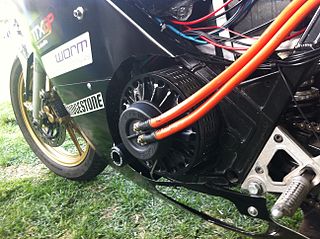
An alternator is an electrical generator that converts mechanical energy to electrical energy in the form of alternating current. For reasons of cost and simplicity, most alternators use a rotating magnetic field with a stationary armature. Occasionally, a linear alternator or a rotating armature with a stationary magnetic field is used. In principle, any AC electrical generator can be called an alternator, but usually, the term refers to small rotating machines driven by automotive and other internal combustion engines.

The Chalmers Motor Company was an American automobile manufacturer headquartered in Detroit, Michigan. Founded in 1908 by Hugh Chalmers, the company was known for producing high-end vehicles. Chalmers automobiles gained recognition for their toughness, durability, and engineering receiving particular praise for their performance in touring events. The company reached its peak in 1911, becoming the eighth-largest auto producer in the United States. Despite initial success, the company faced challenges with increasing competition in the auto industry, and sales began to decline in the following years. In 1923, Chalmers Motor Company merged with Maxwell Motor, ultimately forming the basis for the Chrysler Corporation.

The Brass Era is an American term for the early period of automotive manufacturing, named for the prominent brass fittings used during this time for such features as lights and radiators. It is generally considered to encompass 1896 through 1915, a time when cars were often referred to as horseless carriages.

A continuously variable transmission (CVT) is an automated transmission that can change through a continuous range of gear ratios, typically resulting in better fuel economy in gasoline applications. This contrasts with other transmissions that provide a limited number of gear ratios in fixed steps. The flexibility of a CVT with suitable control may allow the engine to operate at a constant angular velocity while the vehicle moves at varying speeds.

A drive shaft, driveshaft, driving shaft, tailshaft, propeller shaft, or Cardan shaft is a component for transmitting mechanical power, torque, and rotation, usually used to connect other components of a drivetrain that cannot be connected directly because of distance or the need to allow for relative movement between them.

A traction motor is an electric motor used for propulsion of a vehicle, such as locomotives, electric or hydrogen vehicles, or electric multiple unit trains.
A direct-drive mechanism is a mechanism design where the force or torque from a prime mover is transmitted directly to the effector device without involving any intermediate couplings such as a gear train or a belt.

Baker Motor Vehicle Company was an American manufacturer of Brass Era electric automobiles in Cleveland, Ohio, from 1899 to 1914. It was founded by Walter C. Baker.

Woods Motor Vehicle Company was an American manufacturer of electric automobiles in Chicago, Illinois, between 1899 and 1916. In 1915 they produced the Dual Power with both electric and internal combustion engines which continued until 1918.
Justus Bulkley Entz was an American electrical engineer and inventor. He invented the electromagnetic transmission, introduced in the Owen Magnetic of 1915, and was a pioneer in the early automobile industry.

The Lynch motor is a unique axial gap permanent magnet brushed DC electric motor. The motor has a pancake-like shape and was invented by Cedric Lynch in 1979, the relevant patent being filed on 18 December 1986.

The Matheson was a luxury American automobile manufactured from 1903 to 1912, first in Grand Rapids, Michigan, then Holyoke, Massachusetts and from 1906 in a purpose-built factory in Forty Fort, Wilkes-Barre, Pennsylvania.

The Partin Manufacturing Company was a brass era American automobile manufacturer, headquartered at 29 South LaSalle Street, Chicago, Illinois from 1913 to 1917. The Partin-Palmer automobile and Pioneer cyclecar were produced.

The Rauch & Lang Carriage Company was an American electric automobile manufactured in Cleveland, Ohio, from 1905 to 1920 and Chicopee Falls, Massachusetts, from 1920 to 1932.

A magneto is an electrical generator that uses permanent magnets to produce periodic pulses of alternating current. Unlike a dynamo, a magneto does not contain a commutator to produce direct current. It is categorized as a form of alternator, although it is usually considered distinct from most other alternators, which use field coils rather than permanent magnets.

An alternator is a type of electric generator used in modern automobiles to charge the battery and to power the electrical system when its engine is running.

Car controls are the components in automobiles and other powered road vehicles, such as trucks and buses, used for driving and parking.


















